

by Rebecca Lindsey • February 20, 2009
It’s probably not surprising that someone so at home in the snow—she learned to ski before she started school—would eventually wind up where Lora Koenig did this winter. Still, some people might consider her passion for the snow and the cold a little extreme.

NASA glaciologist Lora Koenig at Greenland Summit Camp, January 2009. (Photograph courtesy Lora Koenig.)
Koenig, a remote-sensing glaciologist at NASA’s Goddard Space Flight Center, spent three dark, frigid months on top of the Greenland ice cap. She was one of four people—two scientists, the camp manager, and a mechanic—who staffed the National Science Foundation’s Greenland Summit Camp research station from November 2008 to February 2009.
Summit Camp huddles on the apex of a 3,200-meter-deep ice sheet. An uninterrupted expanse of white extends more than 160 kilometers (100 miles) in all directions. In the winter, temperatures plummet to -50 degrees Celsius. Driven by storms with near-hurricane-force winds, snowdrifts periodically engulf the buildings.
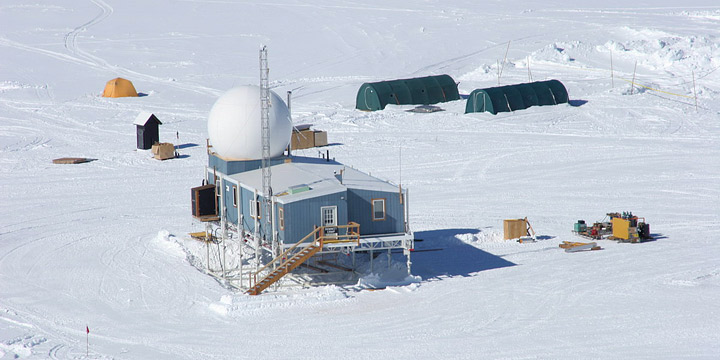
Summit Camp, one of the most isolated spots on Earth, consists of a handful of permanent buildings, surrounded by temporary housing in the summer months. (Photograph courtesy John Burkhart, GEOSummit.)
In the summer, dozens of people—scientists and support staff—converge on Summit Camp. They come to collect observations on everything from winds and temperature, to atmospheric chemistry, to ice elevation, to the types and amount of snow and ice. But in the winter, only two scientists stay to conduct their own research and to keep up the station’s year-round science observations and experiments.

A skeleton crew of four spends the winter on the Greenland Summit. From left to right: Brad Whelchel, Kat Huybers, Lora Koenig, and Bill McCormick. (Photograph courtesy Lora Koenig.)
Koenig blogged about her experiences at the remote outpost and the science going on at Summit Camp. Near the end of her stay, Koenig emailed the Earth Observatory answers to a few questions about how she wound up in Greenland and what is was like to spend the winter there.
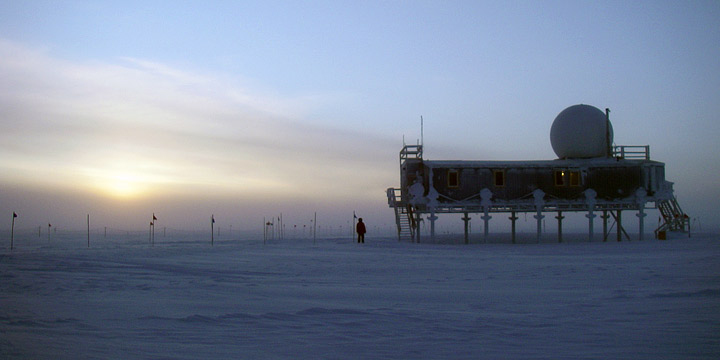
The Sun never gets far above the horizon during the Greenland winter. (Photograph courtesy Lora Koenig.)
I love this question. For me the answer is “reward.” I first came to Greenland in May of 2006, and during the first week of that trip, the Sun would set for about 15 minutes. When the Sun dipped below the horizon I found myself wondering how the ice sheet would look in polar darkness and day-dreaming about what the northern lights would look in the middle of the vast whiteness. I knew then that I wanted to come back in the winter. Last spring I heard of an opening to come to Summit for the second phase of the winter season, and I applied for the opportunity to come. I was thrilled when I was chosen.
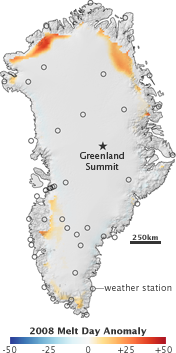
Microwave instruments aboard satellites measure temperature and snow conditions on the Greenland Ice Sheet. The map above shows the 2008 melt day anomaly, the difference from average in the number of days that the surface of the ice melted.
Ibuttons (left, above) are tiny automated sensors Koenig evaluated during her winter stay in Greenland. Ibutton temperature measurements (left, below) could augment satellite measurements and fill in gaps between Greenland’s widely scattered weather stations (indicated by circles on the map above).
(Map based on data from Marco Tedesco. Photograph and graph courtesy Lora Koenig.)
I am taking two types of measurements that will help NASA’s satellite missions. The first are radiometer measurements. [A radiometer is a device that measures the intensity of radiant energy, like radio waves, light, or x-rays.] Over the ice sheets, passive microwave measurements, which are measured by the AMSR-E [Advanced Microwave Scanning Radiometer for the Earth Observing System] sensor on the Aqua satellite, are still not fully understood. The data have shown great potential for monitoring snow accumulation rates in certain areas of the ice sheet, yet not in others, and so the question of ‘why’ remains. My measurements will help us better understand the microwave signal [emitted by the ice and measured by AMSR-E] and, hopefully in the future, produce more accurate maps of temperature and accumulation changes on the ice sheets.
The second measurements I am taking are surface temperature measurements. There is a lack of in situ [on site] temperature measurements on ice sheets because they are vast and harsh. With this project, I am testing a new, inexpensive temperature sensor/data-logger system called an “ibutton.” These sensors are the size of about 5 dimes stacked on top of each other. They are performing very well in the harsh ice sheet environment. If the ibuttons prove worthy, they could be easily and inexpensively distributed to many sites on the ice sheets in Greenland and Antarctica to validate infrared surface temperature products produced by sensors such as MODIS, on board the Aqua and Terra satellites.
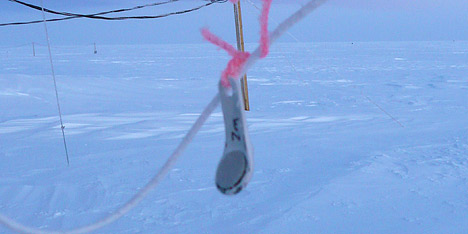

I did not receive too many driving lessons because I have driven snowmobiles on previous research trips. My first snowmobile ride was in Greenland in 2006: I got the snowmobile stuck in a snowdrift and started my “driving” lesson by shoveling the snowmobile out. I did received one driving lesson this winter from our mechanic. In the winter we cannot idle the snowmobiles; they have to stay moving in the extremely cold temperatures so the belts won’t freeze.
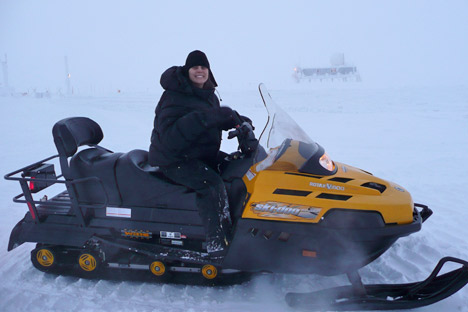
Lora Koenig driving a snowmobile. One of the Summit Camp buildings (the Big House) is in the background. (Photograph courtesy Lora Koenig.)
As for driving the caterpillar, I have also had a driving lesson previously on a trip in Antarctica where we were using caterpillars to pull trains of science equipment. After a 15-minute driving lesson with the caterpillars, I realized I was not great at driving them. I was tentative and constantly worried about getting them stuck. Here at Summit, the manager and mechanic operate the caterpillar, and I am more than happy to watch.
The first day without a sunrise was strange. The horizon looked like the Sun was coming up, and then it never did. It just got dark. Having no sunrise plays with your senses, but I really don’t mind. So far this winter, I have enjoyed the darkness. Most days when I walk the mile round trip to our farthest science experiment, I see amazing stars and northern lights. The only time the dark bothers me is when the winds are above 30 knots [about 35 miles an hour], and the snow is blowing all around. In those conditions, I find myself wishing it was lighter.
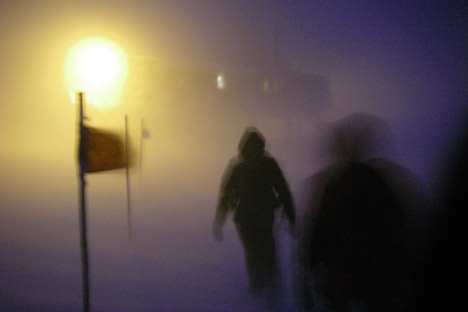
Twenty-four-hour nights on the Greenland Ice Sheet can make trips away from Summit Camp dangerous, especially during storms. High winds and blowing snow make even short trips difficult. (Photograph courtesy Lora Koenig.)
My most frustrating moment so far was when I spent two days preparing to take radiometer measurements and with 4 measurements left to go, I had to quit because a water droplet got in the radiometer horn [a protected cone or cylinder on the front end of the device, where the microwave energy enters the radiometer]. Since water is much more emissive than snow, I had to stop and haul the instruments inside to dry. [Emissivity describes how well a surface radiates energy.] As the radiometer horn was drying, the winds picked up again, blowing snow around and preventing me from finishing the measurements.
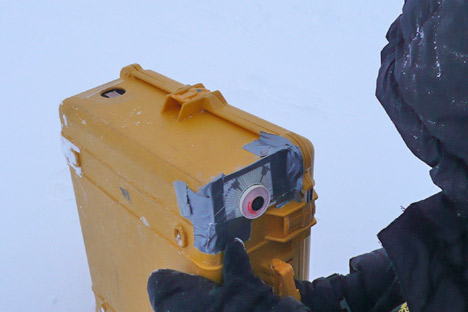
Even enclosed in a hard-sided equipment case, Koenig’s microwave instruments are susceptible to the elements. (Photograph courtesy Lora Koenig.)
I was frustrated because I had spent so much time preparing the snow pit [see Week 9’s blog] and taking the first 11 of 15 measurements that I wanted to finish. I still got good data, but it is frustrating when the weather prevents you from completing science goals.
My scariest moment was when I fell off of a ladder trying to get out of a roof hatch. [Read about snowdrifts in Week 6’s blog.] I was fine but when you have even a small injury you remember how remote you are and how careful you have to be all of the time.
What I will remember for the longest time is how Summit looked in the darkness and the first time the sky was completely lit up by the northern lights.
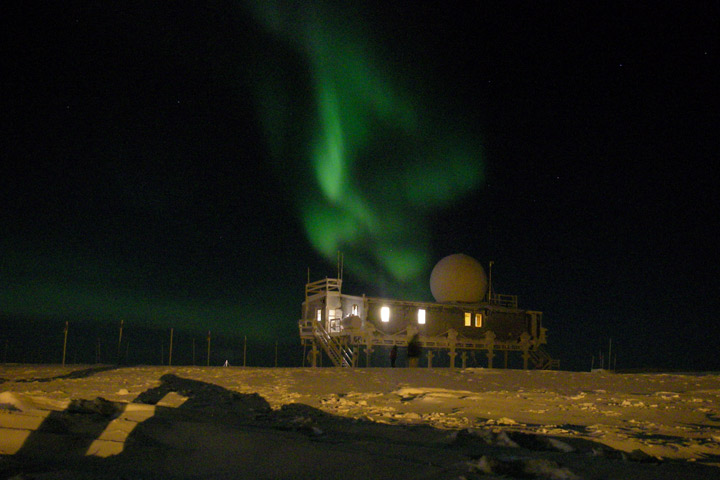
The northern lights. (Photograph courtesy Lora Koenig.)
Hello! My name is Lora Koenig and I am a remote sensing glaciologist and a new hire in the Cryospheric Sciences Branch at the NASA Goddard Space Flight Center. My research uses satellites to monitor the ice sheets, and I am always interested in how well measurements from space compare to those taken on the ground.
My interest in ground truth data and learning more about ice sheets has lead me to spend this winter at Summit, Greenland (Latitude 72.5 N Longitude 38.5 W). Over the course of this weekly blog I will tell you about my life and science, in the middle of the Greenland Ice Sheet, in the middle of the winter. I will start with a quick introduction and explain how I ended up in the dark on an ice sheet. read more
In this blog, I will take a few steps back in time and tell you how I arrived at Summit Camp. I left Washington D.C and flew to Copenhagen, Denmark on Oct 30, 2008. From Copenhagen I took an Air Greenland flight to Kangerlussaq, Greenland on Nov 3, 2008. Kangerlussaq used to be an American military base and hosts Greenland’s international airport. From Kangerlussaq, we all piled in a chartered Air Greenland Twin Otter airplane with skis attached and took the approximately 3 hour flight to Summit. read more
Hello from Summit. This week at Summit we experienced some of our first storms, three to be exact. During the storms the temperatures rose to around -20°C and the wind blows at about 30 knots with gusts up to 40 knots. When the wind blows, snow is lifted from the surface and travels through the air causing drifts around the buildings. The blowing snow also reduces visibility so we can only see about 100 meters. During these conditions we can do very little outside and for safety stay very close to the main camp buildings. read more
We had a festive and busy week here at Summit. We had a busy science week as well as a Thanksgiving dinner to plan. I will start with our Thanksgiving dinner. Kat and I started planning the Thanksgiving menu last Monday. It was important to plan ahead for a few reasons. First most of our food here at Summit is frozen and must be defrosted. The second reason to plan ahead is we have to find the food. Find the food? Well yes, there is quite a bit of food here at Summit. The food is brought in the Summer months on large military planes called LC-130’s that are equipped with skis to land on the ice sheet. The food is frozen and stored in large snow caves underneath the Green House and beside the Big House for the winter season. read more
One of the most common questions I get when doing field work in Greenland is: Are you cold? Well the answer, most of the time, is a resounding no. There is however one exception, my fingers often get very cold. Why am I not cold? Well mainly because we wear lots of cloths.
On a normal day when Kat and I head out to do our daily science rounds we will spend 2-3 hours outdoors. Our outdoor tasks include cleaning the science towers, collecting snow samples, measuring accumulation stakes and launching weather balloons. A normal day’s outfit includes one thin pair of thermal underwear pants, one thick layer of thermal underwear pants, two thermal underwear tops, one thin insulated jacket, a pair of insulated bibs, a down parka, two pairs... read more
The two most commonly used words in camp this week were snow drifts. It was another stormy week, seeing winds upward of 20 kts for 4 days. On Tuesday we recorded the highest winds since we have been here, upwards of 55 kts. As you can imagine we stayed inside for most of the day on Tuesday. When we emerged on Wednesday we found that the camp looked very different. The East winds caused very large drifts to form near the garage doors of the shop and on the tunnel entrance to the Green House. The garage doors to the shop had drifts almost as high as the roof, and drifts had buried the tunnel entrance to the Green House with a foot of snow. read more
Happy Solstice! We made it through the dark and today was a day of celebration at Summit. After surviving our shortest, darkest day, we eagerly await added sunlight as we move away from the solstice. Our first addition of light comes on Dec. 24 when our time in nautical twilight will increase by 2 minutes. On Dec. 15 we lost civilian twilight, when the sun is less than 6° below the horizon, and entered nautical twilight, when the sun is 6 to 12° below the horizon. We’ll regain civilian twilight on Dec. 27 and await our next sunrise Jan, 28, 2009. read more
I hope everyone had a very Merry Christmas. We certainly did at Summit. Christmas morning started with a gift exchange and stockings. We figured we were one of Santa’s first stops. In the afternoon we had a nice Christmas dinner which included lobster tails, mushroom fritters, German cabbage and a chocolate cranberry tart. Yummm! In the evening, as I was walking out to the Flux facility to check on the science machines, the Northern Lights were glowing green and swirling all the way across the sky. I radioed back to camp and we enjoyed the natural Christmas light display. read more
Happy New Year. The New Year brought the best weather we have seen yet at Summit Camp as well as some incredible northern lights. On New Years Day we awoke to no winds and temperature in the -20’s C. We have seen temperatures this high before but they were always accompanied by 30 kts winds. In addition to the warm temperatures we have also had spectacular northern lights each night. We often see the northern lights, usually a single wavy green streak across the sky. This week we have had 4 or more streaks waving across the entire sky and some purple colored auroras as well as the predominant green. read more
Well, as you can see from the temperatures above, we did not get the warmer temperatures we were hoping for. This week was downright cold! Previously I have blogged about the buildings in camp, but I don’t think I mentioned that in the Green House there is a screen with the current weather conditions. We usually check the temperature and wind speed before leaving the Green House and in the mornings when we walk from our rooms to the kitchen for breakfast. This morning, walking from my room to the kitchen, I noticed the temperature was -56 C with 4 kts winds. It was the third day in a row with temperatures around -50 C. read more
Happy Birthday Brad! On Wednesday of this week we celebrated Brad’s 28th birthday with corned beef and cabbage, pasta and a triple chocolate triple layer cake (Figure 38). Brad admits it was his coldest and darkest birthday. Let it be known that even at this altitude, Brad had no trouble blowing out all his candles. Since it was Brad’s week, I thought you might want to hear a bit from him about his work here at Summit as a Mechanic before I talk about science. read more
Our time at Summit is flying by. We are less than two weeks from the new crew arriving for turnover on Feb 6, 2009, weather permitting. With turnover rapidly approaching our focus has changed slightly, beyond our daily, weekly and monthly science projects, our focus this week was on End Of Season (EOS) projects. One end of season task is to write an EOS report that details what we accomplished and lists problems we encountered and the solutions we found. This report passes knowledge on to the next crew. One major thing we detailed in the EOS report was how to keep inlet and outlet tubes clear of blowing snow on the buried Green House roof. read more
On January 29, 2009, one day after our first sunrise, we saw the sun for the first time since November 13, 2008. We did not see the sun on January 28th because of a thick freezing fog, but on the 29th there wasn’t a cloud in the sky. We watched the sun come up over the horizon and then set 1 hour and 59 minutes later. read more
The Summit Camp population is still 4. We had expected the population to be 11 by now but we are still waiting for the arrival of the Twin Otter. The weather in Kangerlussaq has canceled the inbound flight for the past 3 days. Delays are not uncommon on an ice sheet, but they are always a bit hard on morale. It is especially difficult to understand the delays when we have great weather on our end, clear skies, full moon, great sunrises and sunsets. read more
Well the last week, our final week, turned out to be our busiest. On Monday, February 9, the Twin Otter finally arrived on a beautiful sunny, but rather cold,